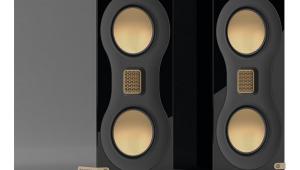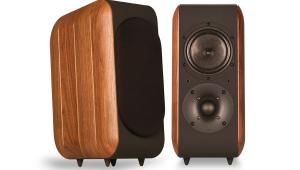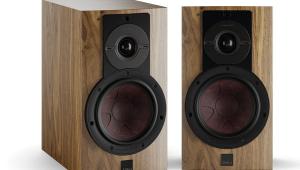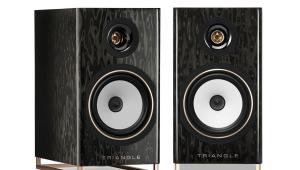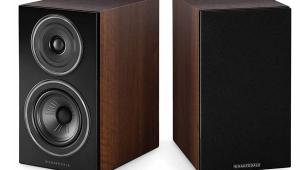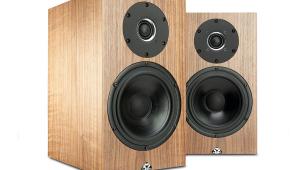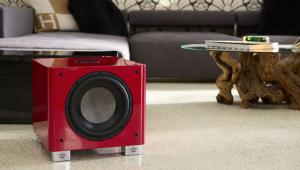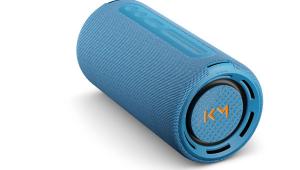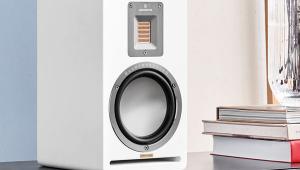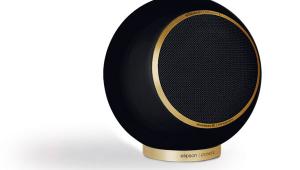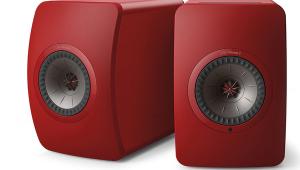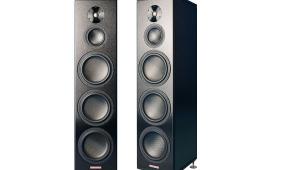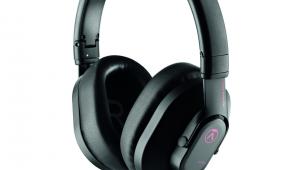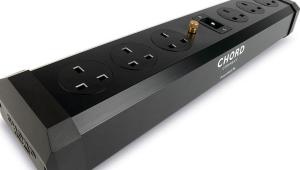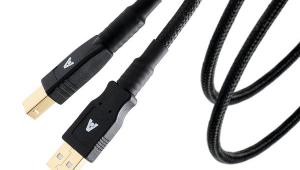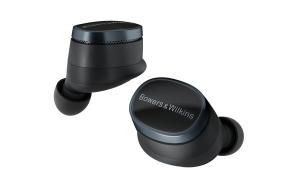KEF Blade 2
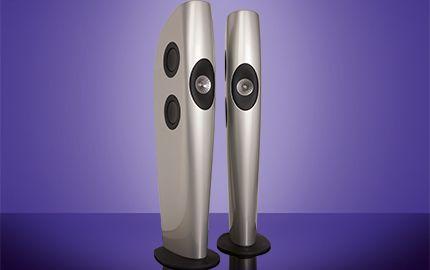
 Producing a concept unit especially for a show or event is a relatively common practise in the car industry, but rather less so in the world of hi-fi. Most companies tend to consider the business of creating items for production to be work enough, but one noble exception is KEF. Having done exactly this with the Muon floorstander, it repeated the process with the Concept Blade, and then managed to get both speaker prototypes into series production.
Producing a concept unit especially for a show or event is a relatively common practise in the car industry, but rather less so in the world of hi-fi. Most companies tend to consider the business of creating items for production to be work enough, but one noble exception is KEF. Having done exactly this with the Muon floorstander, it repeated the process with the Concept Blade, and then managed to get both speaker prototypes into series production.
In the case of the Blade, the result was an extraordinary speaker and one we liked very much. There is no escaping it is also rather large, fairly pricey and somewhat demanding in terms of placement. With this in mind, KEF has taken the design features of the original and produced the Blade Two, which shrinks the dimensions by roughly a third to create a speaker more appropriate for those with smaller rooms.
One look at the Blade Two ought to be sufficient evidence that beyond a spot of shrinkage, other compromises are not on the menu. The speaker is still built around the concept of the ‘Single Apparent Source’ that ensures that the ‘acoustic centre’ of every driver is the same. This gives the brain the impression that it is listening to a single extremely wide bandwidth driver with none of the phase or alignment issues that a conventional forward-facing driver array usually faces.
Key to the success of this approach is an example of KEF’s ubiquitous Uni-Q driver. This is the only driver completely visible to the listener on the leading ‘edge’ of the blade form and combines a 25mm tweeter sat in the throat of a 125mm midrange driver. The latest refinements to the design are present, notably the ‘tangerine’ waveguide that’s designed to widen the dispersion from the tweeter at high frequencies and ensure it more closely matches that of the midrange driver. This duo is exactly the same as the one used in the full-size Blade and sits inside a small, sealed enclosure.
Like the original, the Blade Two partners this forward-facing driver array with a quartet of drivers mounted on the sides of the cabinet in opposed pairs. The reasoning for this is that by doing so, the forces on the cabinet are eliminated by a process of the drivers operating against one another – a technique that is also adopted by some opposed cylinder engines and recoilless rifles. As the Blade Two is smaller, the four 225mm drivers are replaced with 165mm units. The combined radiating area of this quartet is still considerable. Each pair occupies a separate chamber, which is ported via openings of exactly equal lengths to maintain the sense of all drivers hitting the same acoustic centre.
KEF has expended considerable effort ensuring that despite the cabinet mounting six drivers apiece, the overall sensitivity of the Blade Two remains easy to drive. The speaker is strictly a 4ohm design, but the quoted sensitivity of 90dB/1W/1m is pretty impressive for a speaker of this nature. The reduction in size means the low-end extension drops to a quoted 40Hz at +/-3dB in test conditions. KEF suggests that in a room – as opposed to an anechoic chamber – owners should see extension below 30Hz.
The form of the Blade Two is unchanged from the original concept and to my eyes at least, this is a good thing. There is no arguing that the singular appearance is going to be to everyone’s taste – this is never going to be a speaker that vanishes in a room unless you happen to live on a movie set of a utopian future – but I admire the sheer ambition. There is the intriguing addition that the colour you choose has an effect on your perception – I find that in black, the detailing is consumed by the cabinet and robs the appearance of some of its elegance. The silver of the review sample conversely shows that striking form off to great effect while ensuring you can take in the extra design aspects at the same time.
Sound quality
KEF has close ties with Chord Electronics so a DAVE DAC/preamp and SPM 1050 MkII power amp have been made available for testing. It is a simple business to connect my Melco N1A (HFC 397) to the DAVE to create a functional system with my music library to hand. I only need a minute or so of the 24/88.2 SACD rip of Dead Can Dance’s Toward The Within to establish that while it looks spectacular, the form of the Blade Two definitely follows function. The six drivers in each cabinet have the unerring ability to function as one to the extent where there is a disconnect between what your eyes see and ears can hear. The reproduction of the performing space in Rakim lacks any sense of ambiguity about where performers are and the space that they inhabit. More than anything else, the effect is like wearing a giant pair of open-backed headphones.
If you play something rather smaller in scale like Regina Spektor’s Consequence Of Sounds, the KEF shrinks its scale back to the intimacy of a single vocalist and a piano but never loses that cohesion and sense of an almost perfect soundstage. The crossover points between the drivers are utterly imperceptible and the tonality is unaffected by the shift from driver to driver. Even when listening to something comparatively low key and gentle, the impression is extremely dynamic. Spektor’s sharp, staccato vocals leap out of the soundstage with every syllable reproduced with an unwavering intensity. Minute pauses for breath, lost almost everywhere else are here in full. The piano is a physical presence that has meaningful weight to its struck keys and a tangible delay to the notes that are played.
This does mean the Blade Two is not a speaker that is going to cosset you or wrap you in a sort of comforting blanket of sound. It demands your attention and focus in a manner that I suspect won’t appeal to everyone. While it has a superbly refined top end, it has little interest in sugar coating material that is rough or compressed and the whole presentation is the antithesis of ‘background listening’ although if you are spending £16,000 on a pair of speakers to burble away in the background, your priorities are rather different to the norm.
If you accept this, give it your undivided attention and ensure it is fed by suitably capable equipment, the results are unquestionably thrilling. The 24/44.1 download of Scratch Massive’s live Communion album allows the Blade Two to demonstrate every feature in its impressive arsenal. The opening Waiting For A Sign is underpinned by bass that suggests that KEF’s thoughts on the boost in room are entirely accurate. As the chorus kicks in, you are presented with a furious wave of sound that you feel as much as hear.
Once you become used to the sheer scale on offer, you can appreciate that within this enormous presentation, the soundstage is effortlessly detailed and the character of all of the instruments at work are distinct but harmoniously presented as a whole. This is an album that exists to be played loud and the Blade Two is more than up to the challenge. You will need to ensure your amplification is up to the job too, not so much in terms of outright power but in the ability to work with a speaker that will highlight any shortcomings.
Conclusion
This is still a demanding speaker in terms of placement, in partnering equipment and in the listening demands that it makes of you. It should be expected that a speaker that looks the way this one does will never be an unobtrusive wallflower and there are rivals, even at this elevated price (see box out), that might be seen as easier to live with. This doesn’t matter, though. This is an uncompromising piece of engineering brilliance that does things with soundstage, scale, impact and three-dimensionality that are truly exceptional. Anyone lucky enough to own a pair will have a sculpture that’s also one of the most awe-inspiring loudspeakers on sale today. ES
DETAILS
Product: KEF Blade Two
Price: £16,000
Origin: UK
Type: 3-way floorstanding loudspeaker
Weight: 35.3kg
Dimensions (WxHxD): 338 x 1,461 x 475mm
FEATURES
● 25mm Uni-Q aluminium metal dome tweeter with 125mm mid driver
● 4x 165mm mid/bass drivers in opposed pairs
● Quoted sensitivity: 90dB/1W/1m
Distributor: GP Acoustics (UK) Ltd
Telephone: 01622 672261
Website: uk.kef.com
 Read the full reveiw in issue 420
Read the full reveiw in issue 420
 |
Inside this month's issue:
Ruark R610 music system and Sabre-R standmount speakers, PMC twenty.23i Active, floorstanders, English Acoustics Downton preamplifier, Bluesound NODE ICON preamp/streamer, Ortofon Concorde Music Blue MM cartridge and much, much more
|




